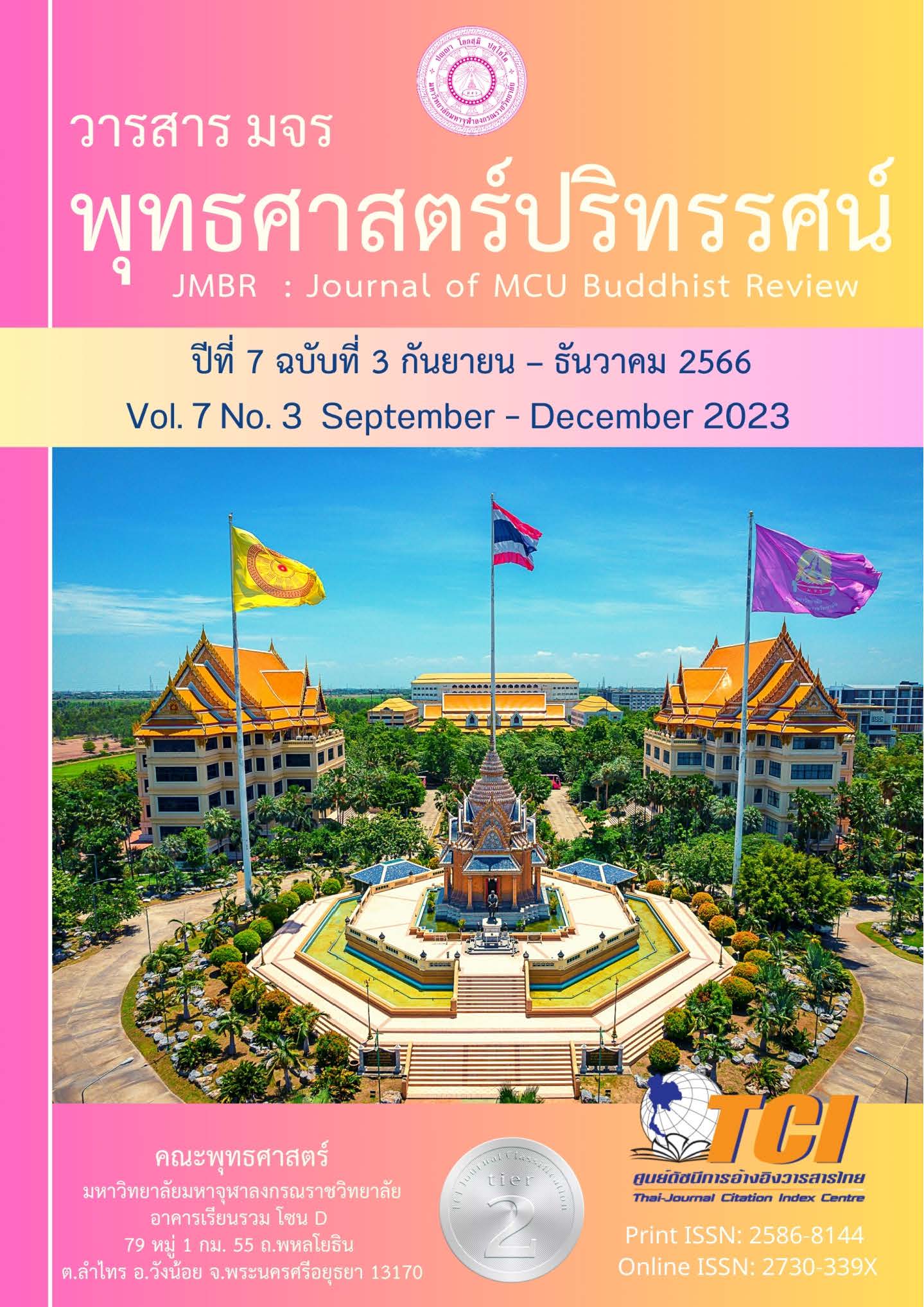บทวิเคราะห์เรื่องกรรมในพุทธปรัชญาเถรวาท
Main Article Content
บทคัดย่อ
หลักกรรมในพุทธปรัชญาเป็นแนวคิดสำคัญที่มีความลึกซึ้ง เพราะเป็นกฎธรรมชาติอย่างหนึ่งที่พระพุทธเจ้าตรัสเรียกว่า กรรมนิยาม กรรมสามารถจำแนกได้หลายลักษณะ ในที่นี้จำแนกเป็น 7 ลักษณะ แต่ละลักษณะมีปรากฏทั้งในพระไตรปิฎกและอรรถกถา ทั้งนี้ เพื่อเป็นการอธิบายกรรมและผลของกรรมให้มีความเข้าใจง่ายยิ่งขึ้น ในบทความนี้ได้วิเคราะห์กรรมใน 3 ด้าน คือ 1) กรรมและประเภทของกรรม 2) องค์ประกอบของกรรม 3) เหตุให้เกิดกรรม ทั้งสามด้านพบองค์ความรู้ใหม่ ดังนี้ 1) ประเด็นกรรมเหนือกรรมดีและชั่ว พบว่า กรรมทั้ง 7 กลุ่ม สามารถสรุปเป็น 2 ประเภทหลัก คือ กรรมดี (บุญ) และกรรมชั่ว (บาป) แต่ก็มีบางกรรมที่อยู่เหนือกรรมดีและกรรมชั่ว นั่นคือ กรรมที่เป็นการกระทำของพระอรหันต์ 2) ประเด็นกรรมฝ่ายสนับสนุนและคัดค้าน พบว่า องค์ประกอบของกรรมทั้งสมบัติ 4 และวิบัติ 4 สามารถสรุปเป็นฝ่ายส่งเสริมและฝ่ายคัดค้านเหมือนกรรม 12 คือ (1) ข้ออุปัตถัมภกกรรม (กรรมสนับสนุน) มีลักษณะคล้ายกรรมฝ่ายส่งเสริม (2) ข้ออุปปีฬกกรรม (กรรมบีบคั้น) และข้ออุปฆาตกกรรม (กรรมเข้าไปตัดรอน) มีลักษณะคล้ายฝ่ายคัดค้าน (ห้าม) 3) ประเด็นกรรมฝ่ายพึงพอใจและไม่พึงพอใจ พบว่า เหตุให้เกิดกรรมสามารถแบ่งเป็น 2 กลุ่ม คือ (1) อิฏฐารมณ์ หมายถึง อารมณ์ที่พึงพอใจ ซึ่งเกิดจากความหลงผิดในกิเลสฝ่ายโลภะ (2) อนิฏฐารมณ์ หมายถึง อารมณ์ที่ไม่พึงพอใจ ซึ่งเกิดจากความหลงผิดในกิเลสฝ่ายโทสะ กิเลสทั้งฝ่ายโลภะและโทสะเกิดจากกิเลสฝ่ายโมหะเป็นต้นตอและสัมพันธ์กับองค์ประกอบของกรรมทั้งด้านสมบัติและวิบัติ
Article Details

อนุญาตภายใต้เงื่อนไข Creative Commons Attribution-NonCommercial-NoDerivatives 4.0 International License.
- บทความที่ได้รับการตีพิมพ์เป็นลิขสิทธิ์ของวารสาร มจร พุทธศาสตร์ปริทรรศน์
- ข้อความใดๆ ที่ปรากฎในบทความที่ได้รับการตีพิมพ์ในวารสาร ถือเป็นความรับผิดชอบของผู้เขียนบทความ และข้อคิดเห็นนั้นไม่ถือว่าเป็นทัศนะและความรับผิดชอบของกองบรรณาธิการวารสาร มจร พุทธศาสตร์ปริทรรศน์
เอกสารอ้างอิง
พระธรรมกิตติวงศ์ (ทองดี สุรเตโช). (2544). คำวัด. กรุงเทพฯ: โรงพิมพ์เลี่ยงเชียง.
พระพรหมคุณาภรณ์ (ป.อ. ปยุตฺโต). (2558ก). พจนานุกรมพุทธศาสตร์ ฉบับประมวลธรรม. พิมพ์ครั้งที่ 31. กรุงเทพฯ: สำนักพิมพ์ผลิธัมม์.
พระพรหมคุณาภรณ์ (ป.อ. ปยุตฺโต). (2558ข). พจนานุกรมพุทธศาสน์ ฉบับประมวลศัพท์. พิมพ์ครั้งที่ 24. กรุงเทพฯ: สำนักพิมพ์ผลิธัมม์.
พระพรหมโมลี (วิลาศ ญาณวโร). (2545). กรรมทีปนี เล่ม 1. กรุงเทพฯ: สำนักพิมพ์ดอกหญ้า 2545.
พระพุทธโฆษาจารย์. (2532). วิสุทธิมรรคเผด็จ เล่ม 3. พิมพ์โดยเสด็จพระราชกุศลออกเมรุพระราชทานเพลิงศพพระวิสุทธาธิบดี (ไสว ฐิตวีรมหาเถร). กรุงเทพฯ: บริษัท จี.เอ. กราฟิค จำกัด.
พุทธทาสภิกขุ. (2542). กรรมเหนือกรรม (กรรมในฐานะกฎแห่งกรรมและกรรมจากพระโอษฐ์). กรุงเทพฯ: สำนักพิมพ์ธรรมสภา.
พุทธทาสภิกขุ. (2544). อิทัปปัจจยตา. กรุงเทพฯ: สำนักพิมพ์สุขภาพใจ.
มหาวิทยาลัยมหาจุฬาลงกรณราชวิทยาลัย. (2539). พระไตรปิฎกภาษาไทย ฉบับมหาจุฬาลงกรณราชวิทยาลัย เล่ม 9, 13, 14, 20, 21, 22, 23, 25, 34, 35. กรุงเทพฯ: โรงพิมพ์มหาจุฬาลงกรณราชวิทยาลัย.
มหาวิทยาลัยมหามกุฏราชวิทยาลัย. (2552). พระไตรปิฎกภาษาบาลี ฉบับสยามรัฐ เล่ม 22. กรุงเทพฯ: โรงพิมพ์มหามกุฏราชวิทยาลัย.
มหาวิทยาลัยมหามกุฏราชวิทยาลัย. (2556 ). พระไตรปิฎกและอรรถกถาแปล ฉบับมหามกุฏราชวิทยาลัย เล่ม 11, 22, 34, 42, 78. พิมพ์ครั้งที่ 8. กรุงเทพฯ: โรงพิมพ์มหามกุฏราชวิทยาลัย.
สมเด็จพระญาณสังวร (สุวฑฺฒโน). (2540). หลักพระพุทธศาสนา. พิมพ์ครั้งที่ 9. กรุงเทพฯ: โรงพิมพ์มหามกุฏราชวิทยาลัย.
อัมพร หุตะสิทธิ์. (2546). กรรม 12 และการให้ผล. วิทยานิพนธ์ปริญญาศิลปศาสตรมหาบัณฑิต สถาบันราชภัฏธนบุรี.


